Clinical Integration 2 Case Study: Peter Ling - Post-Op Hernia Repair
VerifiedAdded on 2022/09/28
|10
|2765
|21
Case Study
AI Summary
This case study focuses on Peter Ling, a 67-year-old patient admitted to the surgical ward after an open mesh inguinal hernia repair. The assignment presents Peter's medical history, including pre-existing conditions like hypertension, hyperlipidemia, and mild congestive heart failure, along wit...
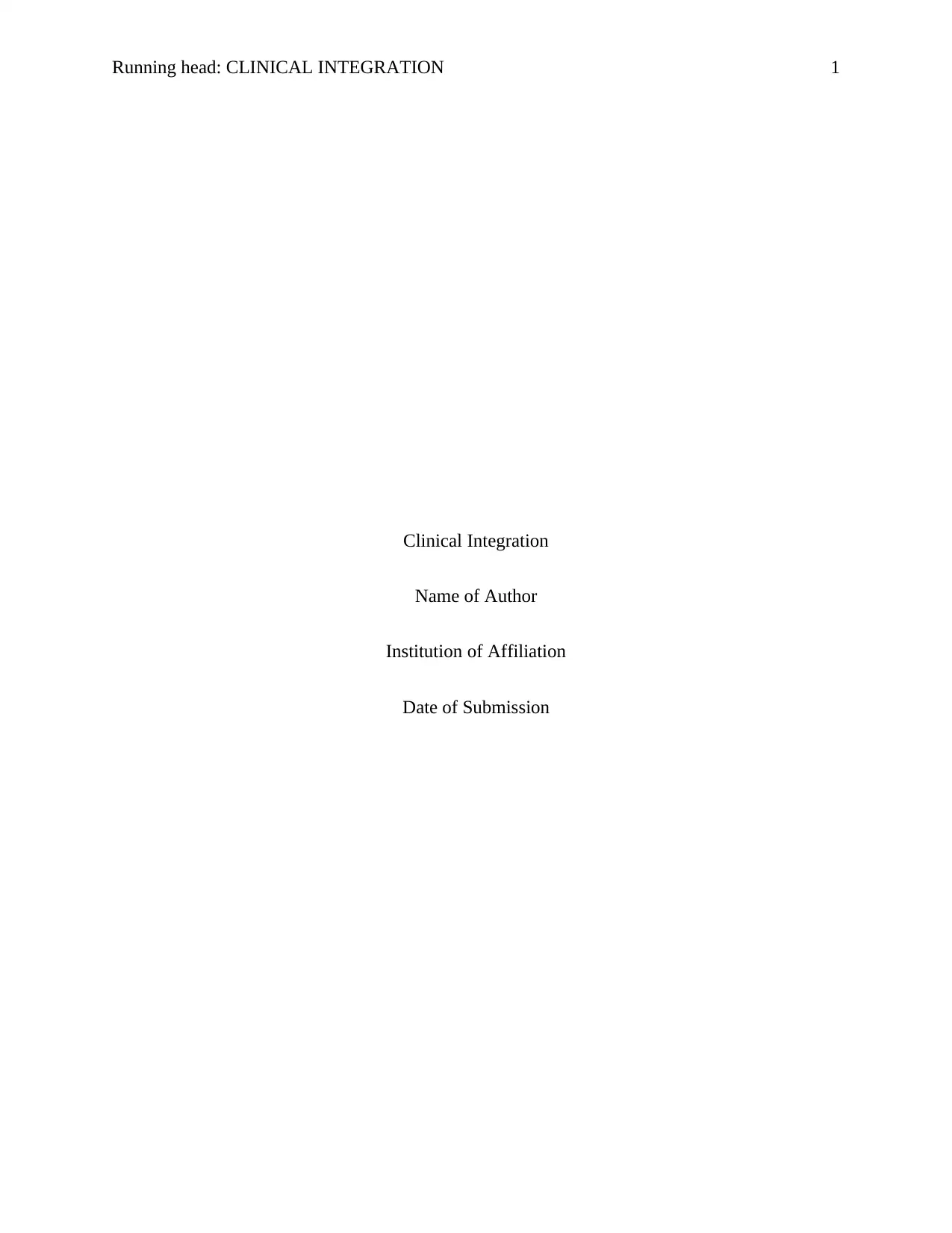
Running head: CLINICAL INTEGRATION 1
Clinical Integration
Name of Author
Institution of Affiliation
Date of Submission
Clinical Integration
Name of Author
Institution of Affiliation
Date of Submission
Paraphrase This Document
Need a fresh take? Get an instant paraphrase of this document with our AI Paraphraser
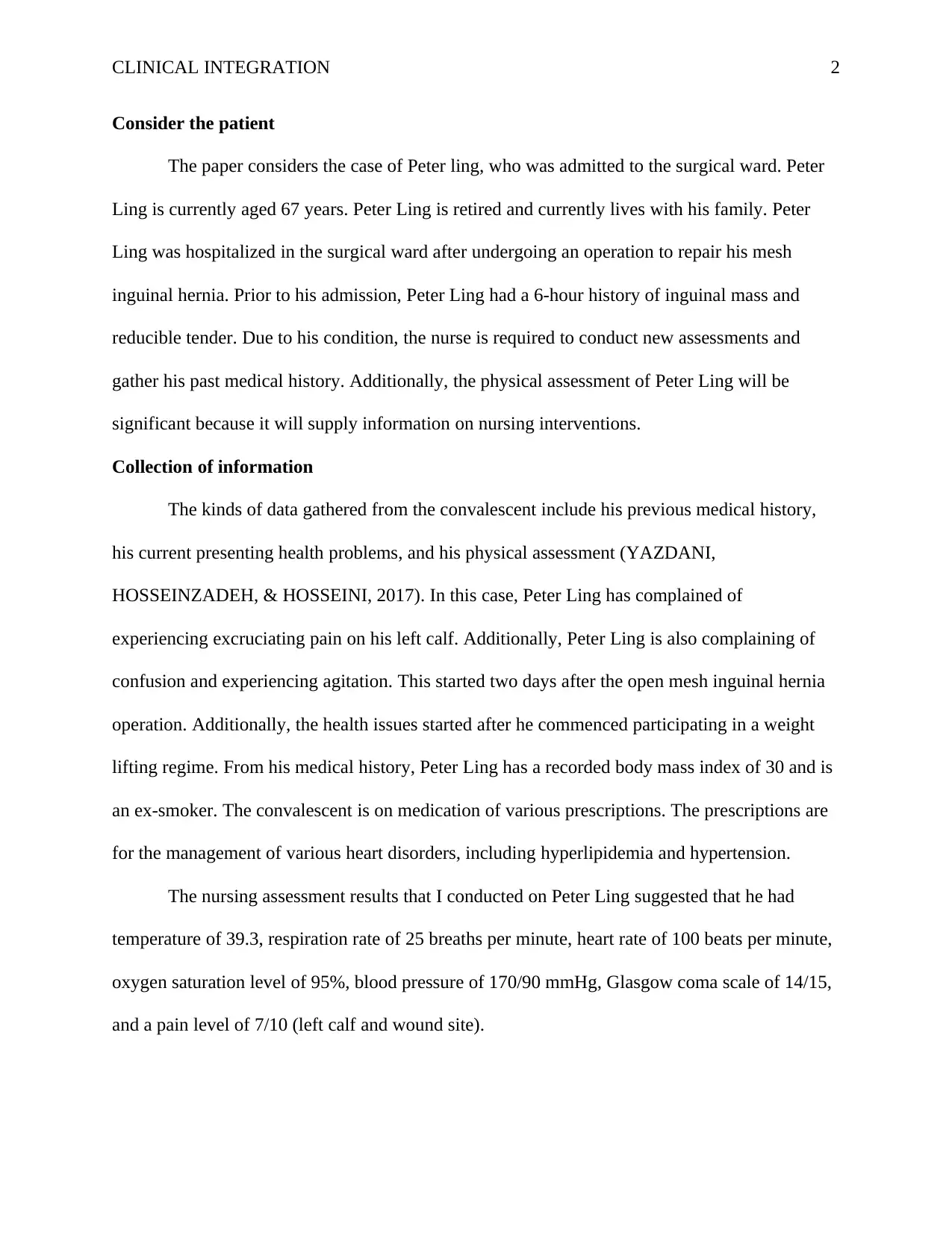
CLINICAL INTEGRATION 2
Consider the patient
The paper considers the case of Peter ling, who was admitted to the surgical ward. Peter
Ling is currently aged 67 years. Peter Ling is retired and currently lives with his family. Peter
Ling was hospitalized in the surgical ward after undergoing an operation to repair his mesh
inguinal hernia. Prior to his admission, Peter Ling had a 6-hour history of inguinal mass and
reducible tender. Due to his condition, the nurse is required to conduct new assessments and
gather his past medical history. Additionally, the physical assessment of Peter Ling will be
significant because it will supply information on nursing interventions.
Collection of information
The kinds of data gathered from the convalescent include his previous medical history,
his current presenting health problems, and his physical assessment (YAZDANI,
HOSSEINZADEH, & HOSSEINI, 2017). In this case, Peter Ling has complained of
experiencing excruciating pain on his left calf. Additionally, Peter Ling is also complaining of
confusion and experiencing agitation. This started two days after the open mesh inguinal hernia
operation. Additionally, the health issues started after he commenced participating in a weight
lifting regime. From his medical history, Peter Ling has a recorded body mass index of 30 and is
an ex-smoker. The convalescent is on medication of various prescriptions. The prescriptions are
for the management of various heart disorders, including hyperlipidemia and hypertension.
The nursing assessment results that I conducted on Peter Ling suggested that he had
temperature of 39.3, respiration rate of 25 breaths per minute, heart rate of 100 beats per minute,
oxygen saturation level of 95%, blood pressure of 170/90 mmHg, Glasgow coma scale of 14/15,
and a pain level of 7/10 (left calf and wound site).
Consider the patient
The paper considers the case of Peter ling, who was admitted to the surgical ward. Peter
Ling is currently aged 67 years. Peter Ling is retired and currently lives with his family. Peter
Ling was hospitalized in the surgical ward after undergoing an operation to repair his mesh
inguinal hernia. Prior to his admission, Peter Ling had a 6-hour history of inguinal mass and
reducible tender. Due to his condition, the nurse is required to conduct new assessments and
gather his past medical history. Additionally, the physical assessment of Peter Ling will be
significant because it will supply information on nursing interventions.
Collection of information
The kinds of data gathered from the convalescent include his previous medical history,
his current presenting health problems, and his physical assessment (YAZDANI,
HOSSEINZADEH, & HOSSEINI, 2017). In this case, Peter Ling has complained of
experiencing excruciating pain on his left calf. Additionally, Peter Ling is also complaining of
confusion and experiencing agitation. This started two days after the open mesh inguinal hernia
operation. Additionally, the health issues started after he commenced participating in a weight
lifting regime. From his medical history, Peter Ling has a recorded body mass index of 30 and is
an ex-smoker. The convalescent is on medication of various prescriptions. The prescriptions are
for the management of various heart disorders, including hyperlipidemia and hypertension.
The nursing assessment results that I conducted on Peter Ling suggested that he had
temperature of 39.3, respiration rate of 25 breaths per minute, heart rate of 100 beats per minute,
oxygen saturation level of 95%, blood pressure of 170/90 mmHg, Glasgow coma scale of 14/15,
and a pain level of 7/10 (left calf and wound site).
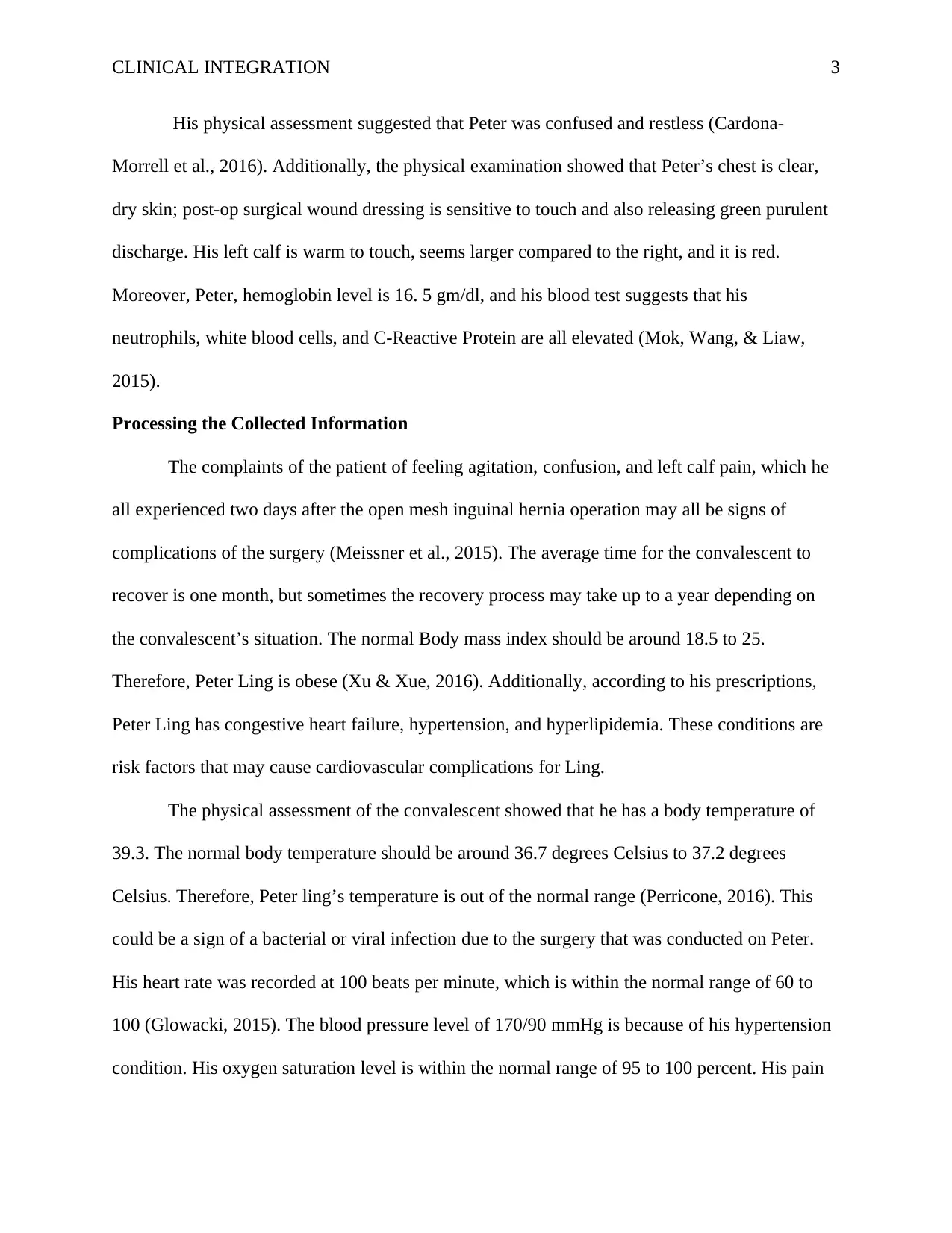
CLINICAL INTEGRATION 3
His physical assessment suggested that Peter was confused and restless (Cardona-
Morrell et al., 2016). Additionally, the physical examination showed that Peter’s chest is clear,
dry skin; post-op surgical wound dressing is sensitive to touch and also releasing green purulent
discharge. His left calf is warm to touch, seems larger compared to the right, and it is red.
Moreover, Peter, hemoglobin level is 16. 5 gm/dl, and his blood test suggests that his
neutrophils, white blood cells, and C-Reactive Protein are all elevated (Mok, Wang, & Liaw,
2015).
Processing the Collected Information
The complaints of the patient of feeling agitation, confusion, and left calf pain, which he
all experienced two days after the open mesh inguinal hernia operation may all be signs of
complications of the surgery (Meissner et al., 2015). The average time for the convalescent to
recover is one month, but sometimes the recovery process may take up to a year depending on
the convalescent’s situation. The normal Body mass index should be around 18.5 to 25.
Therefore, Peter Ling is obese (Xu & Xue, 2016). Additionally, according to his prescriptions,
Peter Ling has congestive heart failure, hypertension, and hyperlipidemia. These conditions are
risk factors that may cause cardiovascular complications for Ling.
The physical assessment of the convalescent showed that he has a body temperature of
39.3. The normal body temperature should be around 36.7 degrees Celsius to 37.2 degrees
Celsius. Therefore, Peter ling’s temperature is out of the normal range (Perricone, 2016). This
could be a sign of a bacterial or viral infection due to the surgery that was conducted on Peter.
His heart rate was recorded at 100 beats per minute, which is within the normal range of 60 to
100 (Glowacki, 2015). The blood pressure level of 170/90 mmHg is because of his hypertension
condition. His oxygen saturation level is within the normal range of 95 to 100 percent. His pain
His physical assessment suggested that Peter was confused and restless (Cardona-
Morrell et al., 2016). Additionally, the physical examination showed that Peter’s chest is clear,
dry skin; post-op surgical wound dressing is sensitive to touch and also releasing green purulent
discharge. His left calf is warm to touch, seems larger compared to the right, and it is red.
Moreover, Peter, hemoglobin level is 16. 5 gm/dl, and his blood test suggests that his
neutrophils, white blood cells, and C-Reactive Protein are all elevated (Mok, Wang, & Liaw,
2015).
Processing the Collected Information
The complaints of the patient of feeling agitation, confusion, and left calf pain, which he
all experienced two days after the open mesh inguinal hernia operation may all be signs of
complications of the surgery (Meissner et al., 2015). The average time for the convalescent to
recover is one month, but sometimes the recovery process may take up to a year depending on
the convalescent’s situation. The normal Body mass index should be around 18.5 to 25.
Therefore, Peter Ling is obese (Xu & Xue, 2016). Additionally, according to his prescriptions,
Peter Ling has congestive heart failure, hypertension, and hyperlipidemia. These conditions are
risk factors that may cause cardiovascular complications for Ling.
The physical assessment of the convalescent showed that he has a body temperature of
39.3. The normal body temperature should be around 36.7 degrees Celsius to 37.2 degrees
Celsius. Therefore, Peter ling’s temperature is out of the normal range (Perricone, 2016). This
could be a sign of a bacterial or viral infection due to the surgery that was conducted on Peter.
His heart rate was recorded at 100 beats per minute, which is within the normal range of 60 to
100 (Glowacki, 2015). The blood pressure level of 170/90 mmHg is because of his hypertension
condition. His oxygen saturation level is within the normal range of 95 to 100 percent. His pain
⊘ This is a preview!⊘
Do you want full access?
Subscribe today to unlock all pages.

Trusted by 1+ million students worldwide
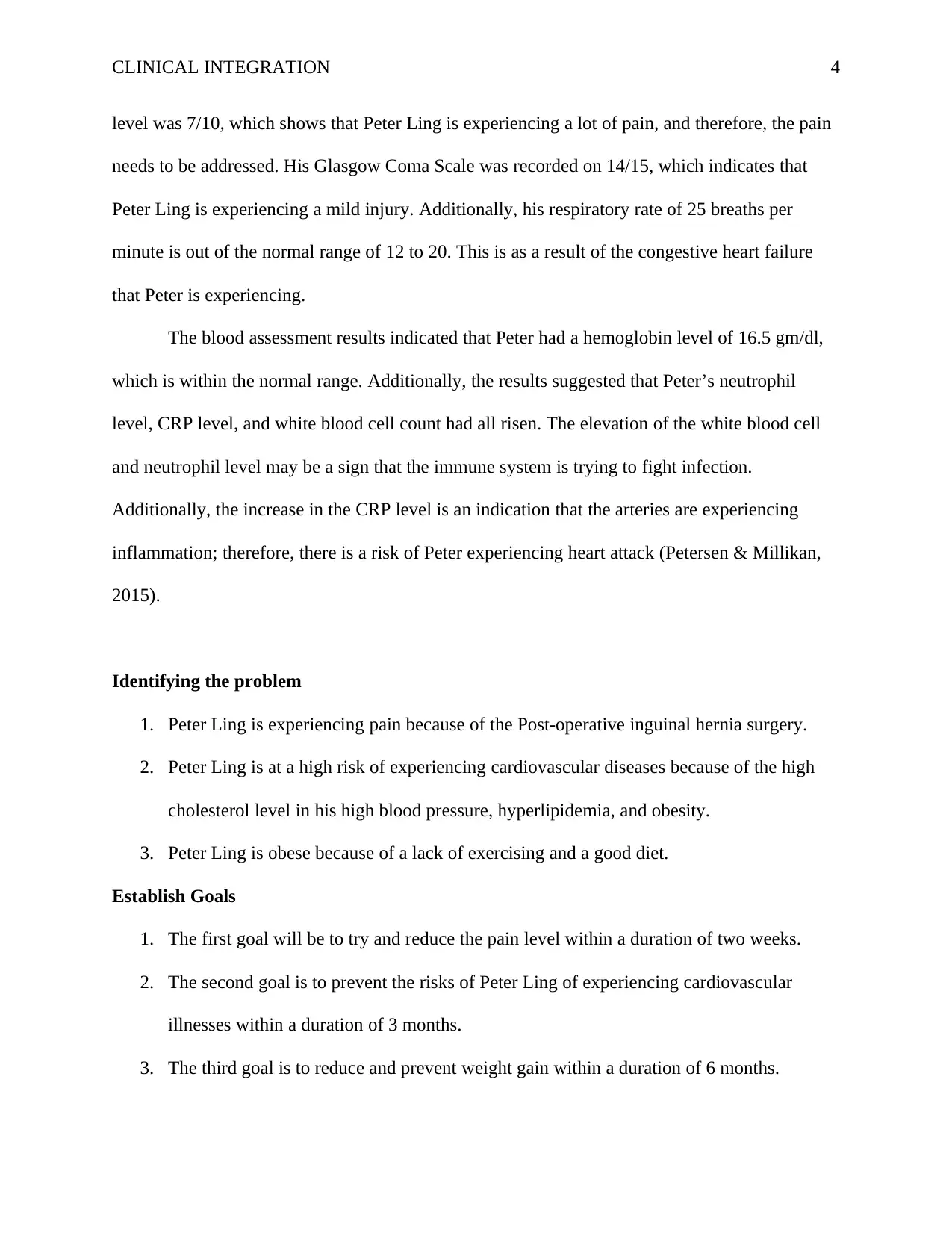
CLINICAL INTEGRATION 4
level was 7/10, which shows that Peter Ling is experiencing a lot of pain, and therefore, the pain
needs to be addressed. His Glasgow Coma Scale was recorded on 14/15, which indicates that
Peter Ling is experiencing a mild injury. Additionally, his respiratory rate of 25 breaths per
minute is out of the normal range of 12 to 20. This is as a result of the congestive heart failure
that Peter is experiencing.
The blood assessment results indicated that Peter had a hemoglobin level of 16.5 gm/dl,
which is within the normal range. Additionally, the results suggested that Peter’s neutrophil
level, CRP level, and white blood cell count had all risen. The elevation of the white blood cell
and neutrophil level may be a sign that the immune system is trying to fight infection.
Additionally, the increase in the CRP level is an indication that the arteries are experiencing
inflammation; therefore, there is a risk of Peter experiencing heart attack (Petersen & Millikan,
2015).
Identifying the problem
1. Peter Ling is experiencing pain because of the Post-operative inguinal hernia surgery.
2. Peter Ling is at a high risk of experiencing cardiovascular diseases because of the high
cholesterol level in his high blood pressure, hyperlipidemia, and obesity.
3. Peter Ling is obese because of a lack of exercising and a good diet.
Establish Goals
1. The first goal will be to try and reduce the pain level within a duration of two weeks.
2. The second goal is to prevent the risks of Peter Ling of experiencing cardiovascular
illnesses within a duration of 3 months.
3. The third goal is to reduce and prevent weight gain within a duration of 6 months.
level was 7/10, which shows that Peter Ling is experiencing a lot of pain, and therefore, the pain
needs to be addressed. His Glasgow Coma Scale was recorded on 14/15, which indicates that
Peter Ling is experiencing a mild injury. Additionally, his respiratory rate of 25 breaths per
minute is out of the normal range of 12 to 20. This is as a result of the congestive heart failure
that Peter is experiencing.
The blood assessment results indicated that Peter had a hemoglobin level of 16.5 gm/dl,
which is within the normal range. Additionally, the results suggested that Peter’s neutrophil
level, CRP level, and white blood cell count had all risen. The elevation of the white blood cell
and neutrophil level may be a sign that the immune system is trying to fight infection.
Additionally, the increase in the CRP level is an indication that the arteries are experiencing
inflammation; therefore, there is a risk of Peter experiencing heart attack (Petersen & Millikan,
2015).
Identifying the problem
1. Peter Ling is experiencing pain because of the Post-operative inguinal hernia surgery.
2. Peter Ling is at a high risk of experiencing cardiovascular diseases because of the high
cholesterol level in his high blood pressure, hyperlipidemia, and obesity.
3. Peter Ling is obese because of a lack of exercising and a good diet.
Establish Goals
1. The first goal will be to try and reduce the pain level within a duration of two weeks.
2. The second goal is to prevent the risks of Peter Ling of experiencing cardiovascular
illnesses within a duration of 3 months.
3. The third goal is to reduce and prevent weight gain within a duration of 6 months.
Paraphrase This Document
Need a fresh take? Get an instant paraphrase of this document with our AI Paraphraser
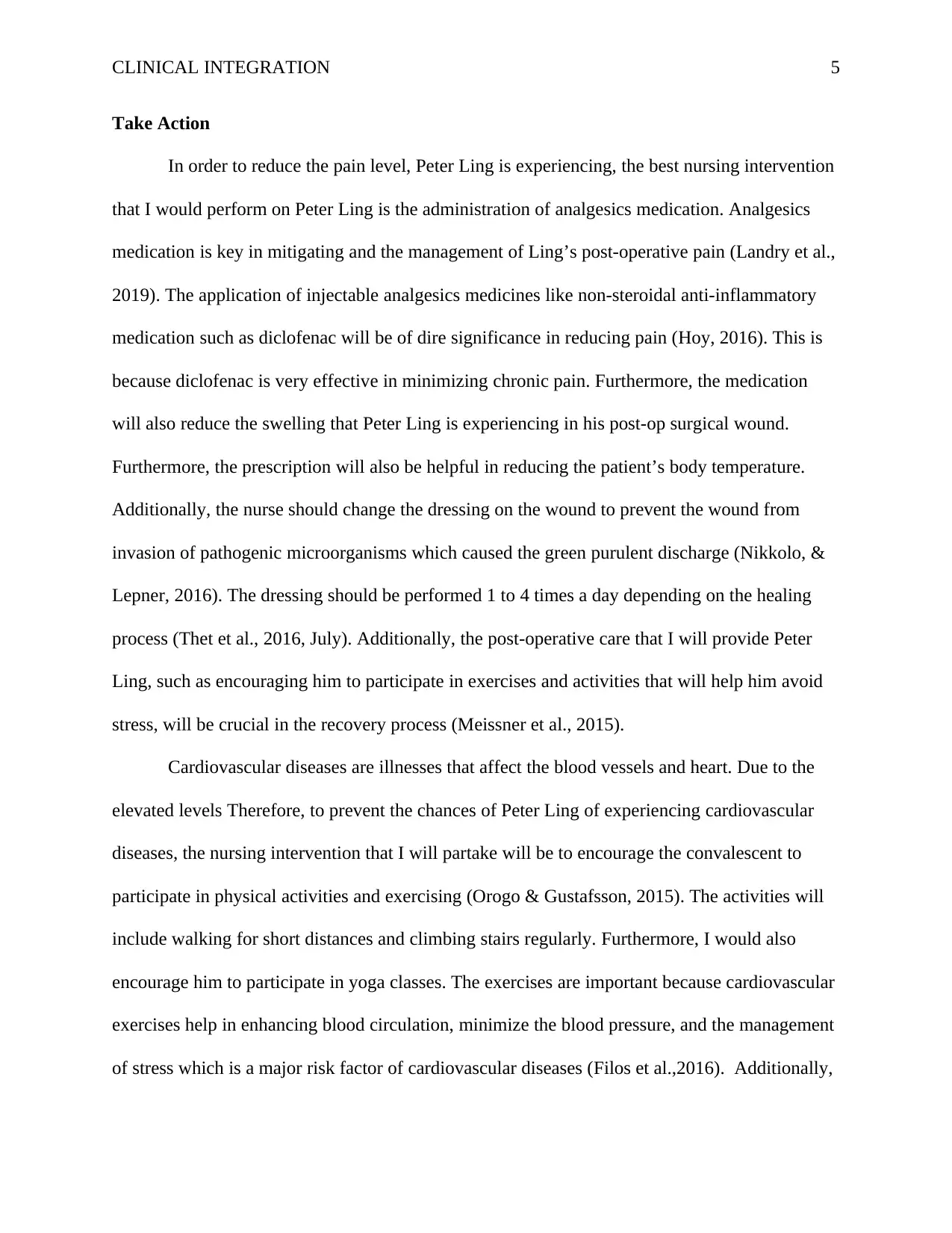
CLINICAL INTEGRATION 5
Take Action
In order to reduce the pain level, Peter Ling is experiencing, the best nursing intervention
that I would perform on Peter Ling is the administration of analgesics medication. Analgesics
medication is key in mitigating and the management of Ling’s post-operative pain (Landry et al.,
2019). The application of injectable analgesics medicines like non-steroidal anti-inflammatory
medication such as diclofenac will be of dire significance in reducing pain (Hoy, 2016). This is
because diclofenac is very effective in minimizing chronic pain. Furthermore, the medication
will also reduce the swelling that Peter Ling is experiencing in his post-op surgical wound.
Furthermore, the prescription will also be helpful in reducing the patient’s body temperature.
Additionally, the nurse should change the dressing on the wound to prevent the wound from
invasion of pathogenic microorganisms which caused the green purulent discharge (Nikkolo, &
Lepner, 2016). The dressing should be performed 1 to 4 times a day depending on the healing
process (Thet et al., 2016, July). Additionally, the post-operative care that I will provide Peter
Ling, such as encouraging him to participate in exercises and activities that will help him avoid
stress, will be crucial in the recovery process (Meissner et al., 2015).
Cardiovascular diseases are illnesses that affect the blood vessels and heart. Due to the
elevated levels Therefore, to prevent the chances of Peter Ling of experiencing cardiovascular
diseases, the nursing intervention that I will partake will be to encourage the convalescent to
participate in physical activities and exercising (Orogo & Gustafsson, 2015). The activities will
include walking for short distances and climbing stairs regularly. Furthermore, I would also
encourage him to participate in yoga classes. The exercises are important because cardiovascular
exercises help in enhancing blood circulation, minimize the blood pressure, and the management
of stress which is a major risk factor of cardiovascular diseases (Filos et al.,2016). Additionally,
Take Action
In order to reduce the pain level, Peter Ling is experiencing, the best nursing intervention
that I would perform on Peter Ling is the administration of analgesics medication. Analgesics
medication is key in mitigating and the management of Ling’s post-operative pain (Landry et al.,
2019). The application of injectable analgesics medicines like non-steroidal anti-inflammatory
medication such as diclofenac will be of dire significance in reducing pain (Hoy, 2016). This is
because diclofenac is very effective in minimizing chronic pain. Furthermore, the medication
will also reduce the swelling that Peter Ling is experiencing in his post-op surgical wound.
Furthermore, the prescription will also be helpful in reducing the patient’s body temperature.
Additionally, the nurse should change the dressing on the wound to prevent the wound from
invasion of pathogenic microorganisms which caused the green purulent discharge (Nikkolo, &
Lepner, 2016). The dressing should be performed 1 to 4 times a day depending on the healing
process (Thet et al., 2016, July). Additionally, the post-operative care that I will provide Peter
Ling, such as encouraging him to participate in exercises and activities that will help him avoid
stress, will be crucial in the recovery process (Meissner et al., 2015).
Cardiovascular diseases are illnesses that affect the blood vessels and heart. Due to the
elevated levels Therefore, to prevent the chances of Peter Ling of experiencing cardiovascular
diseases, the nursing intervention that I will partake will be to encourage the convalescent to
participate in physical activities and exercising (Orogo & Gustafsson, 2015). The activities will
include walking for short distances and climbing stairs regularly. Furthermore, I would also
encourage him to participate in yoga classes. The exercises are important because cardiovascular
exercises help in enhancing blood circulation, minimize the blood pressure, and the management
of stress which is a major risk factor of cardiovascular diseases (Filos et al.,2016). Additionally,
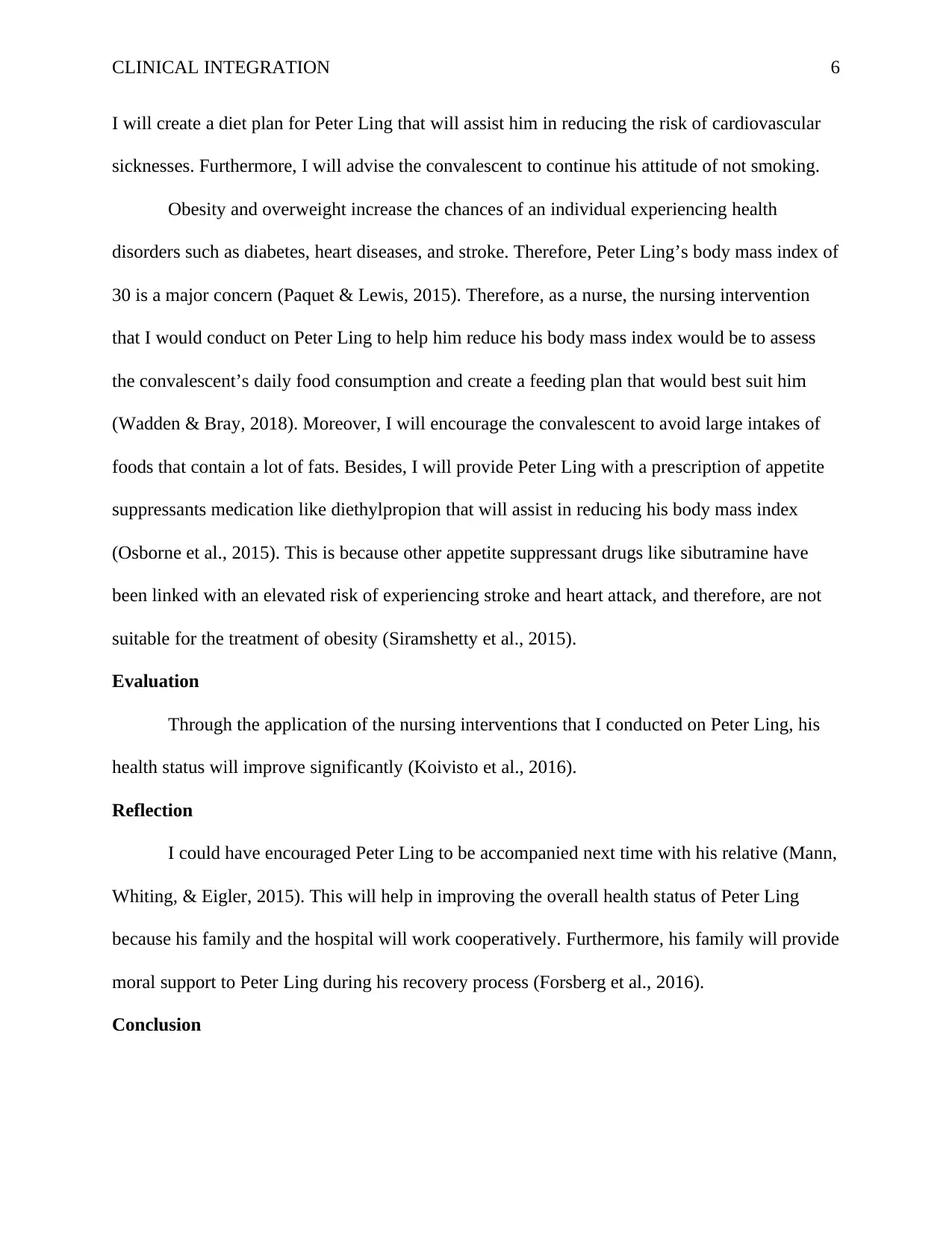
CLINICAL INTEGRATION 6
I will create a diet plan for Peter Ling that will assist him in reducing the risk of cardiovascular
sicknesses. Furthermore, I will advise the convalescent to continue his attitude of not smoking.
Obesity and overweight increase the chances of an individual experiencing health
disorders such as diabetes, heart diseases, and stroke. Therefore, Peter Ling’s body mass index of
30 is a major concern (Paquet & Lewis, 2015). Therefore, as a nurse, the nursing intervention
that I would conduct on Peter Ling to help him reduce his body mass index would be to assess
the convalescent’s daily food consumption and create a feeding plan that would best suit him
(Wadden & Bray, 2018). Moreover, I will encourage the convalescent to avoid large intakes of
foods that contain a lot of fats. Besides, I will provide Peter Ling with a prescription of appetite
suppressants medication like diethylpropion that will assist in reducing his body mass index
(Osborne et al., 2015). This is because other appetite suppressant drugs like sibutramine have
been linked with an elevated risk of experiencing stroke and heart attack, and therefore, are not
suitable for the treatment of obesity (Siramshetty et al., 2015).
Evaluation
Through the application of the nursing interventions that I conducted on Peter Ling, his
health status will improve significantly (Koivisto et al., 2016).
Reflection
I could have encouraged Peter Ling to be accompanied next time with his relative (Mann,
Whiting, & Eigler, 2015). This will help in improving the overall health status of Peter Ling
because his family and the hospital will work cooperatively. Furthermore, his family will provide
moral support to Peter Ling during his recovery process (Forsberg et al., 2016).
Conclusion
I will create a diet plan for Peter Ling that will assist him in reducing the risk of cardiovascular
sicknesses. Furthermore, I will advise the convalescent to continue his attitude of not smoking.
Obesity and overweight increase the chances of an individual experiencing health
disorders such as diabetes, heart diseases, and stroke. Therefore, Peter Ling’s body mass index of
30 is a major concern (Paquet & Lewis, 2015). Therefore, as a nurse, the nursing intervention
that I would conduct on Peter Ling to help him reduce his body mass index would be to assess
the convalescent’s daily food consumption and create a feeding plan that would best suit him
(Wadden & Bray, 2018). Moreover, I will encourage the convalescent to avoid large intakes of
foods that contain a lot of fats. Besides, I will provide Peter Ling with a prescription of appetite
suppressants medication like diethylpropion that will assist in reducing his body mass index
(Osborne et al., 2015). This is because other appetite suppressant drugs like sibutramine have
been linked with an elevated risk of experiencing stroke and heart attack, and therefore, are not
suitable for the treatment of obesity (Siramshetty et al., 2015).
Evaluation
Through the application of the nursing interventions that I conducted on Peter Ling, his
health status will improve significantly (Koivisto et al., 2016).
Reflection
I could have encouraged Peter Ling to be accompanied next time with his relative (Mann,
Whiting, & Eigler, 2015). This will help in improving the overall health status of Peter Ling
because his family and the hospital will work cooperatively. Furthermore, his family will provide
moral support to Peter Ling during his recovery process (Forsberg et al., 2016).
Conclusion
⊘ This is a preview!⊘
Do you want full access?
Subscribe today to unlock all pages.

Trusted by 1+ million students worldwide
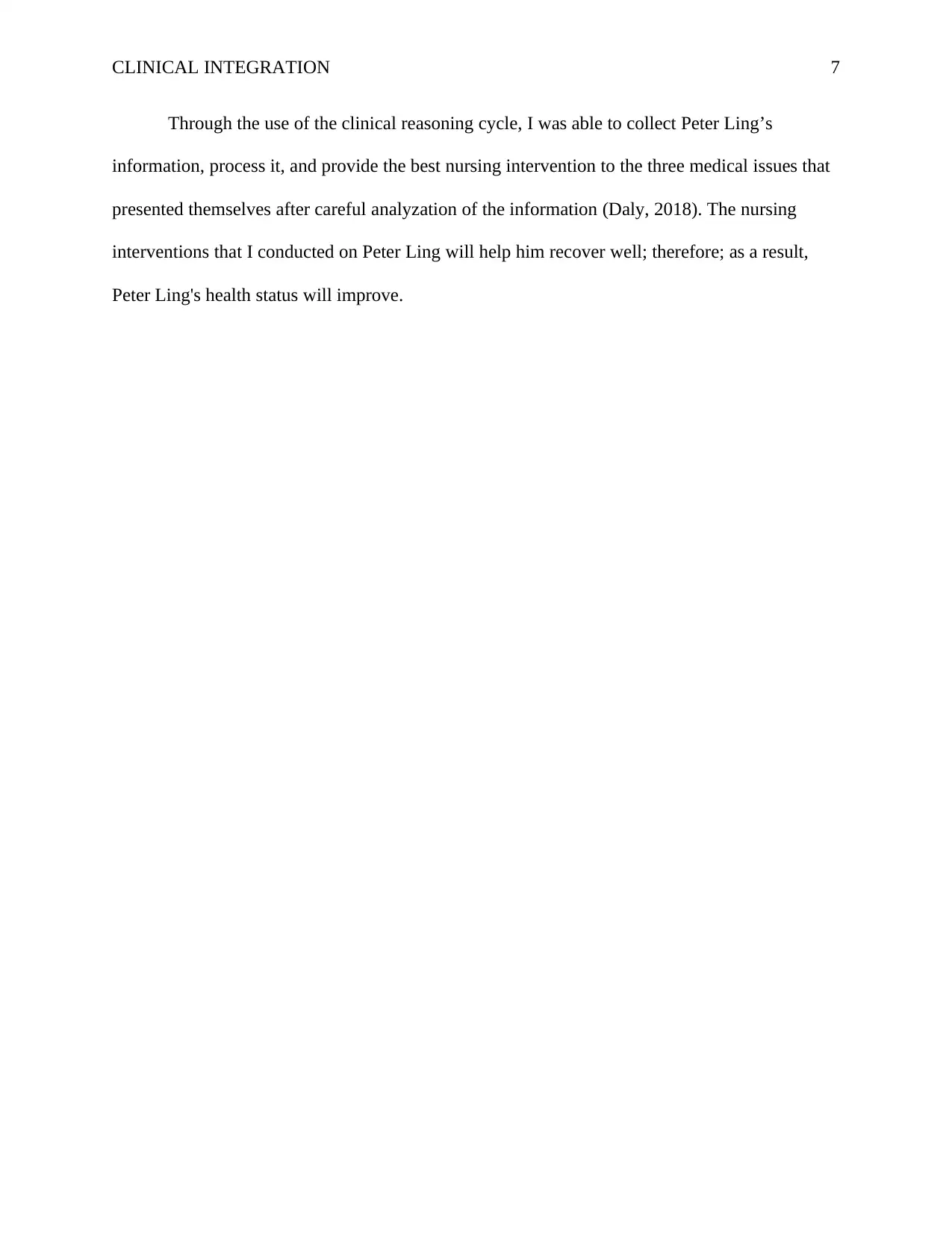
CLINICAL INTEGRATION 7
Through the use of the clinical reasoning cycle, I was able to collect Peter Ling’s
information, process it, and provide the best nursing intervention to the three medical issues that
presented themselves after careful analyzation of the information (Daly, 2018). The nursing
interventions that I conducted on Peter Ling will help him recover well; therefore; as a result,
Peter Ling's health status will improve.
Through the use of the clinical reasoning cycle, I was able to collect Peter Ling’s
information, process it, and provide the best nursing intervention to the three medical issues that
presented themselves after careful analyzation of the information (Daly, 2018). The nursing
interventions that I conducted on Peter Ling will help him recover well; therefore; as a result,
Peter Ling's health status will improve.
Paraphrase This Document
Need a fresh take? Get an instant paraphrase of this document with our AI Paraphraser
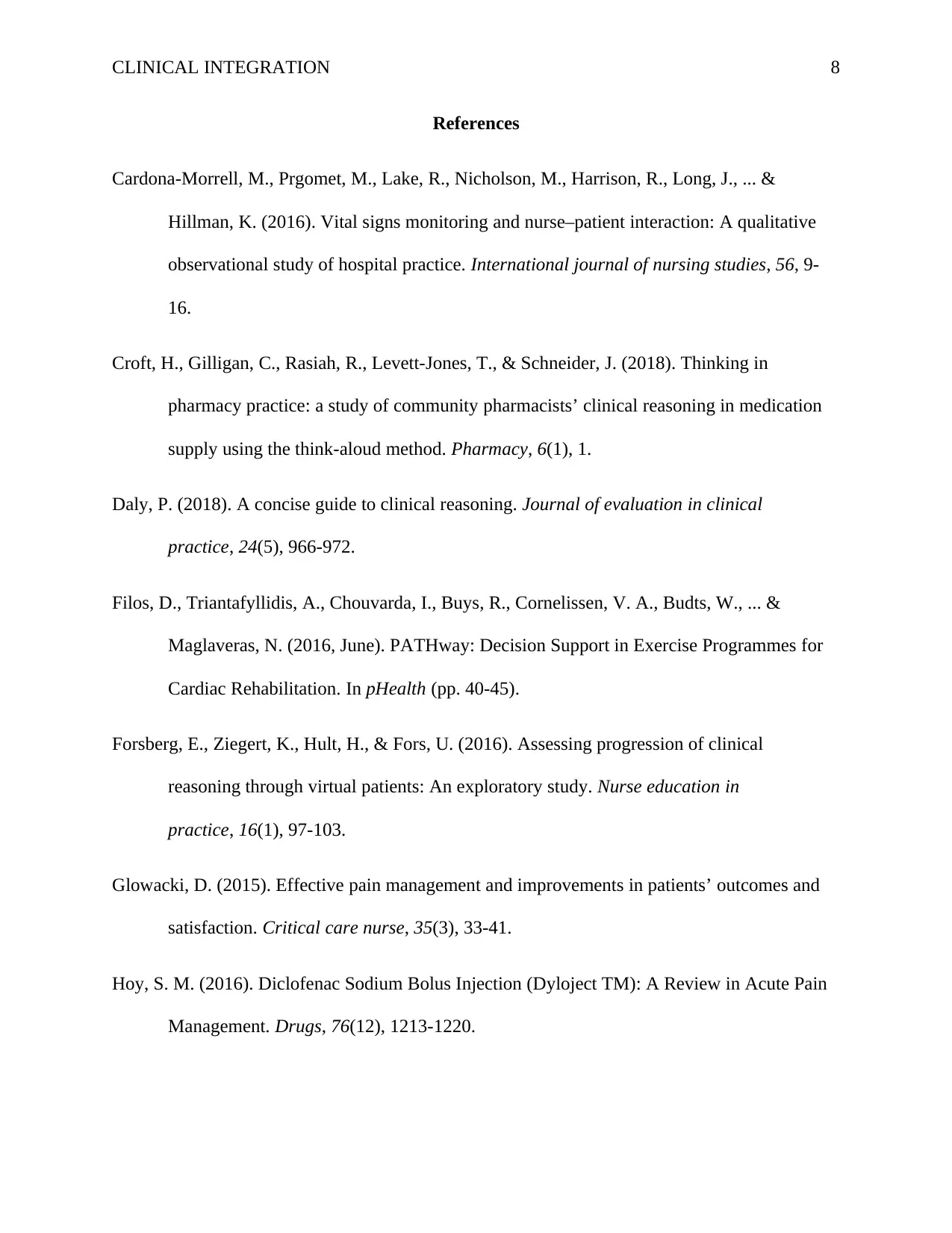
CLINICAL INTEGRATION 8
References
Cardona-Morrell, M., Prgomet, M., Lake, R., Nicholson, M., Harrison, R., Long, J., ... &
Hillman, K. (2016). Vital signs monitoring and nurse–patient interaction: A qualitative
observational study of hospital practice. International journal of nursing studies, 56, 9-
16.
Croft, H., Gilligan, C., Rasiah, R., Levett-Jones, T., & Schneider, J. (2018). Thinking in
pharmacy practice: a study of community pharmacists’ clinical reasoning in medication
supply using the think-aloud method. Pharmacy, 6(1), 1.
Daly, P. (2018). A concise guide to clinical reasoning. Journal of evaluation in clinical
practice, 24(5), 966-972.
Filos, D., Triantafyllidis, A., Chouvarda, I., Buys, R., Cornelissen, V. A., Budts, W., ... &
Maglaveras, N. (2016, June). PATHway: Decision Support in Exercise Programmes for
Cardiac Rehabilitation. In pHealth (pp. 40-45).
Forsberg, E., Ziegert, K., Hult, H., & Fors, U. (2016). Assessing progression of clinical
reasoning through virtual patients: An exploratory study. Nurse education in
practice, 16(1), 97-103.
Glowacki, D. (2015). Effective pain management and improvements in patients’ outcomes and
satisfaction. Critical care nurse, 35(3), 33-41.
Hoy, S. M. (2016). Diclofenac Sodium Bolus Injection (Dyloject TM): A Review in Acute Pain
Management. Drugs, 76(12), 1213-1220.
References
Cardona-Morrell, M., Prgomet, M., Lake, R., Nicholson, M., Harrison, R., Long, J., ... &
Hillman, K. (2016). Vital signs monitoring and nurse–patient interaction: A qualitative
observational study of hospital practice. International journal of nursing studies, 56, 9-
16.
Croft, H., Gilligan, C., Rasiah, R., Levett-Jones, T., & Schneider, J. (2018). Thinking in
pharmacy practice: a study of community pharmacists’ clinical reasoning in medication
supply using the think-aloud method. Pharmacy, 6(1), 1.
Daly, P. (2018). A concise guide to clinical reasoning. Journal of evaluation in clinical
practice, 24(5), 966-972.
Filos, D., Triantafyllidis, A., Chouvarda, I., Buys, R., Cornelissen, V. A., Budts, W., ... &
Maglaveras, N. (2016, June). PATHway: Decision Support in Exercise Programmes for
Cardiac Rehabilitation. In pHealth (pp. 40-45).
Forsberg, E., Ziegert, K., Hult, H., & Fors, U. (2016). Assessing progression of clinical
reasoning through virtual patients: An exploratory study. Nurse education in
practice, 16(1), 97-103.
Glowacki, D. (2015). Effective pain management and improvements in patients’ outcomes and
satisfaction. Critical care nurse, 35(3), 33-41.
Hoy, S. M. (2016). Diclofenac Sodium Bolus Injection (Dyloject TM): A Review in Acute Pain
Management. Drugs, 76(12), 1213-1220.
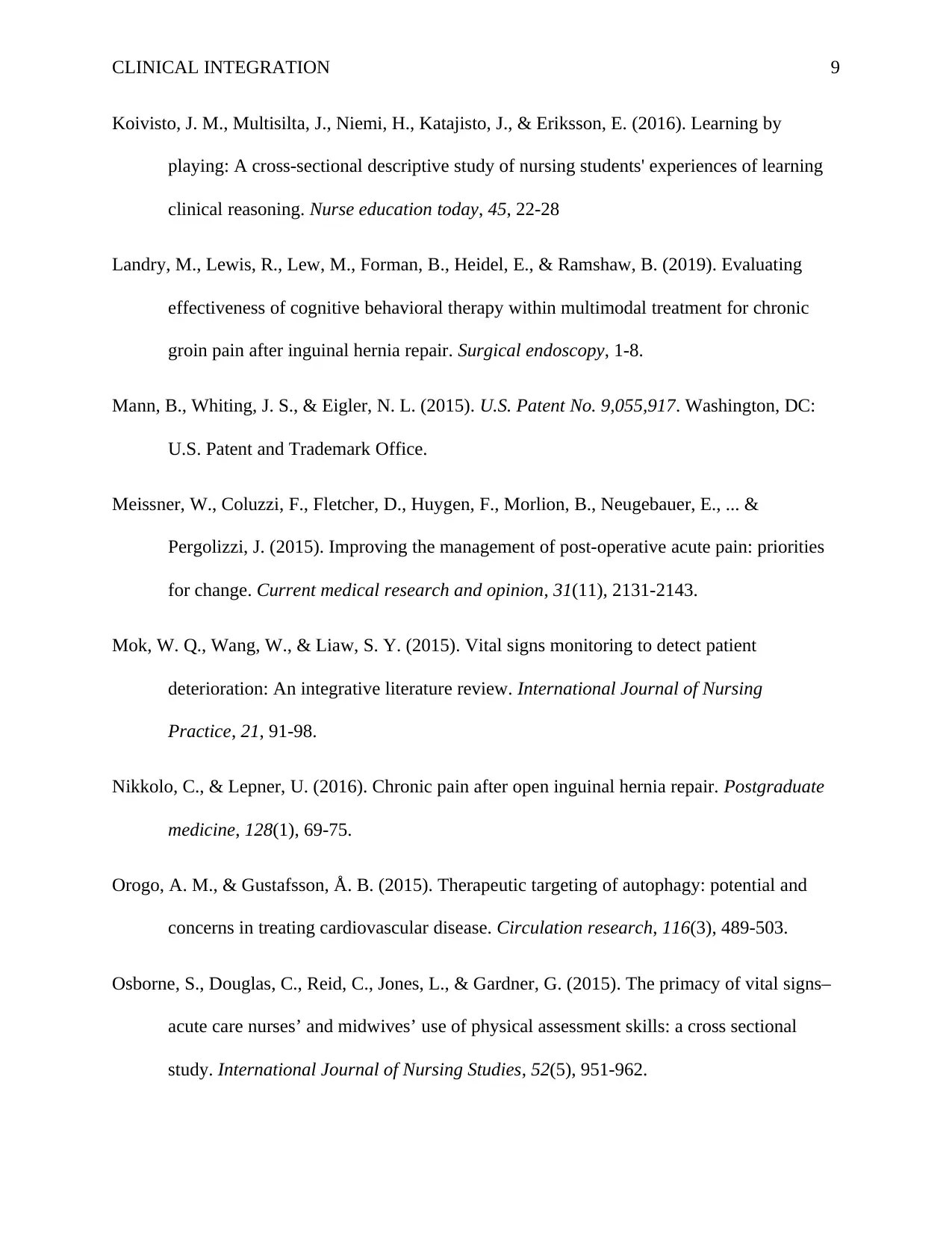
CLINICAL INTEGRATION 9
Koivisto, J. M., Multisilta, J., Niemi, H., Katajisto, J., & Eriksson, E. (2016). Learning by
playing: A cross-sectional descriptive study of nursing students' experiences of learning
clinical reasoning. Nurse education today, 45, 22-28
Landry, M., Lewis, R., Lew, M., Forman, B., Heidel, E., & Ramshaw, B. (2019). Evaluating
effectiveness of cognitive behavioral therapy within multimodal treatment for chronic
groin pain after inguinal hernia repair. Surgical endoscopy, 1-8.
Mann, B., Whiting, J. S., & Eigler, N. L. (2015). U.S. Patent No. 9,055,917. Washington, DC:
U.S. Patent and Trademark Office.
Meissner, W., Coluzzi, F., Fletcher, D., Huygen, F., Morlion, B., Neugebauer, E., ... &
Pergolizzi, J. (2015). Improving the management of post-operative acute pain: priorities
for change. Current medical research and opinion, 31(11), 2131-2143.
Mok, W. Q., Wang, W., & Liaw, S. Y. (2015). Vital signs monitoring to detect patient
deterioration: An integrative literature review. International Journal of Nursing
Practice, 21, 91-98.
Nikkolo, C., & Lepner, U. (2016). Chronic pain after open inguinal hernia repair. Postgraduate
medicine, 128(1), 69-75.
Orogo, A. M., & Gustafsson, Å. B. (2015). Therapeutic targeting of autophagy: potential and
concerns in treating cardiovascular disease. Circulation research, 116(3), 489-503.
Osborne, S., Douglas, C., Reid, C., Jones, L., & Gardner, G. (2015). The primacy of vital signs–
acute care nurses’ and midwives’ use of physical assessment skills: a cross sectional
study. International Journal of Nursing Studies, 52(5), 951-962.
Koivisto, J. M., Multisilta, J., Niemi, H., Katajisto, J., & Eriksson, E. (2016). Learning by
playing: A cross-sectional descriptive study of nursing students' experiences of learning
clinical reasoning. Nurse education today, 45, 22-28
Landry, M., Lewis, R., Lew, M., Forman, B., Heidel, E., & Ramshaw, B. (2019). Evaluating
effectiveness of cognitive behavioral therapy within multimodal treatment for chronic
groin pain after inguinal hernia repair. Surgical endoscopy, 1-8.
Mann, B., Whiting, J. S., & Eigler, N. L. (2015). U.S. Patent No. 9,055,917. Washington, DC:
U.S. Patent and Trademark Office.
Meissner, W., Coluzzi, F., Fletcher, D., Huygen, F., Morlion, B., Neugebauer, E., ... &
Pergolizzi, J. (2015). Improving the management of post-operative acute pain: priorities
for change. Current medical research and opinion, 31(11), 2131-2143.
Mok, W. Q., Wang, W., & Liaw, S. Y. (2015). Vital signs monitoring to detect patient
deterioration: An integrative literature review. International Journal of Nursing
Practice, 21, 91-98.
Nikkolo, C., & Lepner, U. (2016). Chronic pain after open inguinal hernia repair. Postgraduate
medicine, 128(1), 69-75.
Orogo, A. M., & Gustafsson, Å. B. (2015). Therapeutic targeting of autophagy: potential and
concerns in treating cardiovascular disease. Circulation research, 116(3), 489-503.
Osborne, S., Douglas, C., Reid, C., Jones, L., & Gardner, G. (2015). The primacy of vital signs–
acute care nurses’ and midwives’ use of physical assessment skills: a cross sectional
study. International Journal of Nursing Studies, 52(5), 951-962.
⊘ This is a preview!⊘
Do you want full access?
Subscribe today to unlock all pages.

Trusted by 1+ million students worldwide
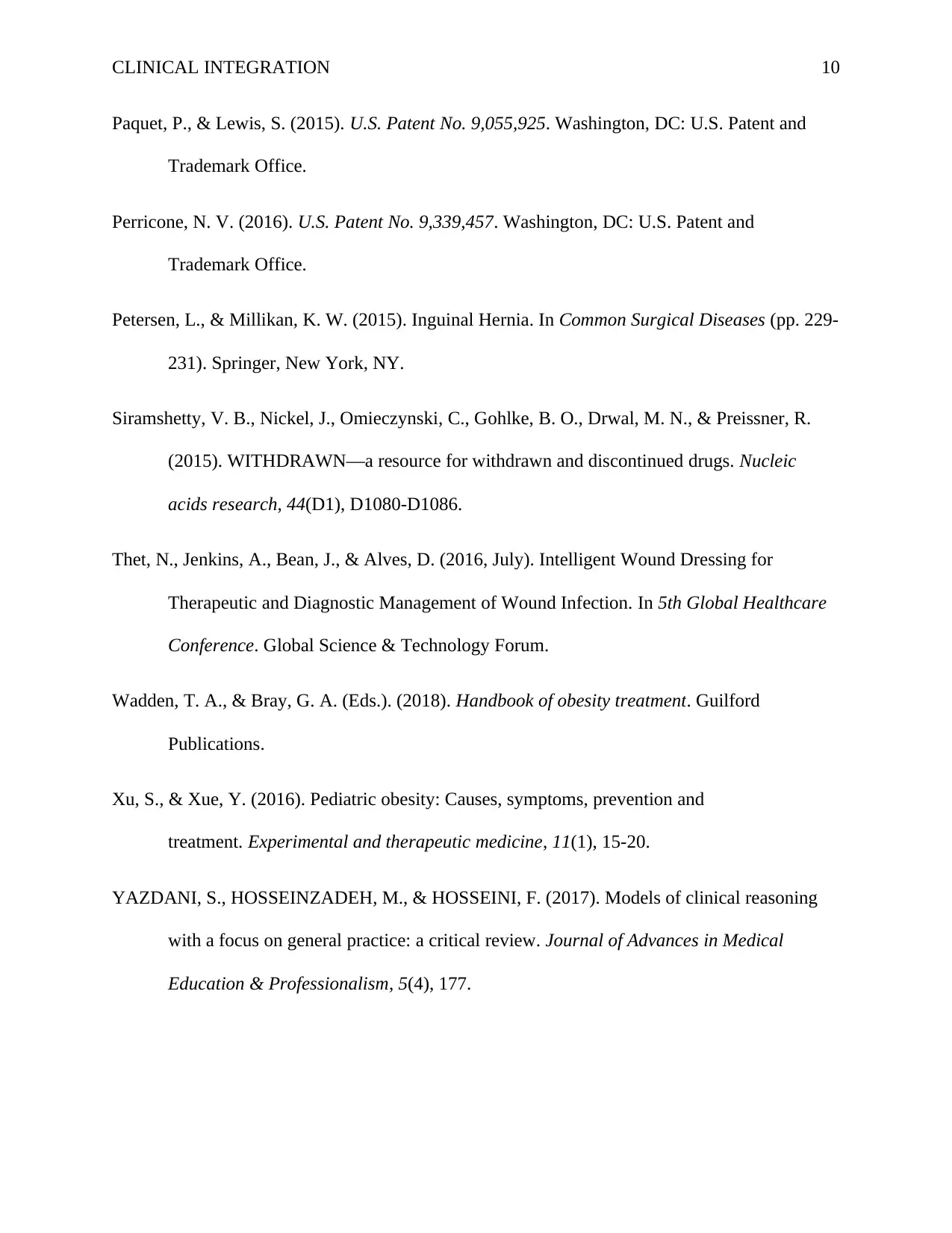
CLINICAL INTEGRATION 10
Paquet, P., & Lewis, S. (2015). U.S. Patent No. 9,055,925. Washington, DC: U.S. Patent and
Trademark Office.
Perricone, N. V. (2016). U.S. Patent No. 9,339,457. Washington, DC: U.S. Patent and
Trademark Office.
Petersen, L., & Millikan, K. W. (2015). Inguinal Hernia. In Common Surgical Diseases (pp. 229-
231). Springer, New York, NY.
Siramshetty, V. B., Nickel, J., Omieczynski, C., Gohlke, B. O., Drwal, M. N., & Preissner, R.
(2015). WITHDRAWN—a resource for withdrawn and discontinued drugs. Nucleic
acids research, 44(D1), D1080-D1086.
Thet, N., Jenkins, A., Bean, J., & Alves, D. (2016, July). Intelligent Wound Dressing for
Therapeutic and Diagnostic Management of Wound Infection. In 5th Global Healthcare
Conference. Global Science & Technology Forum.
Wadden, T. A., & Bray, G. A. (Eds.). (2018). Handbook of obesity treatment. Guilford
Publications.
Xu, S., & Xue, Y. (2016). Pediatric obesity: Causes, symptoms, prevention and
treatment. Experimental and therapeutic medicine, 11(1), 15-20.
YAZDANI, S., HOSSEINZADEH, M., & HOSSEINI, F. (2017). Models of clinical reasoning
with a focus on general practice: a critical review. Journal of Advances in Medical
Education & Professionalism, 5(4), 177.
Paquet, P., & Lewis, S. (2015). U.S. Patent No. 9,055,925. Washington, DC: U.S. Patent and
Trademark Office.
Perricone, N. V. (2016). U.S. Patent No. 9,339,457. Washington, DC: U.S. Patent and
Trademark Office.
Petersen, L., & Millikan, K. W. (2015). Inguinal Hernia. In Common Surgical Diseases (pp. 229-
231). Springer, New York, NY.
Siramshetty, V. B., Nickel, J., Omieczynski, C., Gohlke, B. O., Drwal, M. N., & Preissner, R.
(2015). WITHDRAWN—a resource for withdrawn and discontinued drugs. Nucleic
acids research, 44(D1), D1080-D1086.
Thet, N., Jenkins, A., Bean, J., & Alves, D. (2016, July). Intelligent Wound Dressing for
Therapeutic and Diagnostic Management of Wound Infection. In 5th Global Healthcare
Conference. Global Science & Technology Forum.
Wadden, T. A., & Bray, G. A. (Eds.). (2018). Handbook of obesity treatment. Guilford
Publications.
Xu, S., & Xue, Y. (2016). Pediatric obesity: Causes, symptoms, prevention and
treatment. Experimental and therapeutic medicine, 11(1), 15-20.
YAZDANI, S., HOSSEINZADEH, M., & HOSSEINI, F. (2017). Models of clinical reasoning
with a focus on general practice: a critical review. Journal of Advances in Medical
Education & Professionalism, 5(4), 177.
1 out of 10
Related Documents
Your All-in-One AI-Powered Toolkit for Academic Success.
+13062052269
info@desklib.com
Available 24*7 on WhatsApp / Email
![[object Object]](/_next/static/media/star-bottom.7253800d.svg)
Unlock your academic potential
© 2024 | Zucol Services PVT LTD | All rights reserved.





